Community Profile: Fort Knox Helps Protect Economy of Elizabethtown, Ky.
Photo Gallery | Article
Photo Gallery
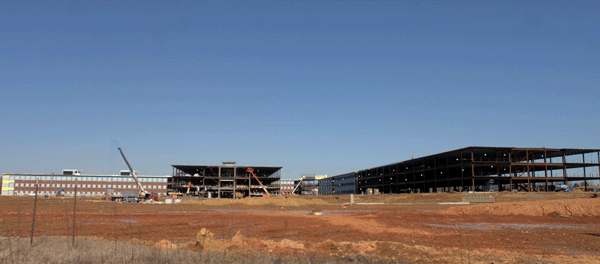
The human resources command center being built at Fort Knox will have 900,000 square feet of office space. Between 1,500 and 1,800 civilians are expected to be hired for new positions there.
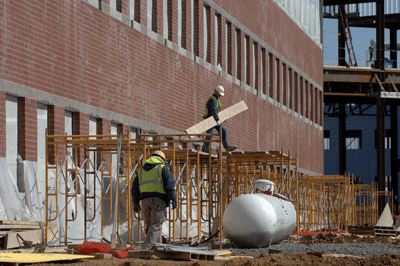
Construction continues on Fort Knox's human resources command center, which will be equal in size to 15 football fields.
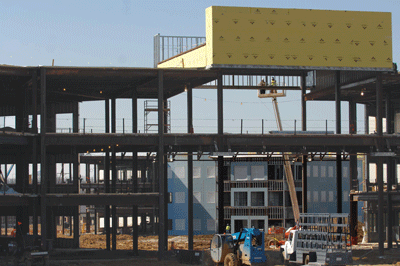
Fort Knox's new human resources command center will consolidate such functions from Army facilities around the country.
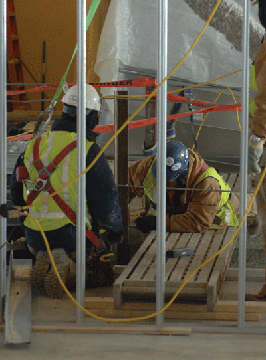
Hundreds of local trades people are working on the construction at Fort Knox.
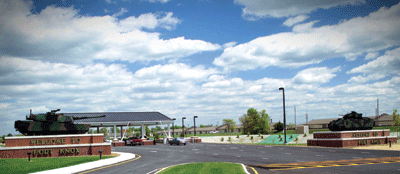
Tanks appear to salute visitors at one of the gates to Fort Knox.
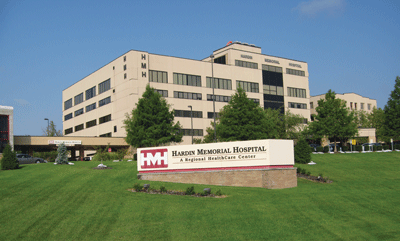
With 1,600 workers, Hardin Memorial Hospital is the No. 1 employer in Elizabethtown. Bad debts are ballooning at the hospital as more uninsured and underinsured people seek services there.
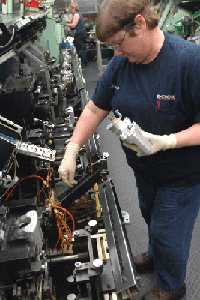
At the Akebono Brake Corp. plant, Barbara Hardesty assembles disc brakes. The Tokyo-based company moved its North American headquarters to Elizabethtown from Michigan in 2007
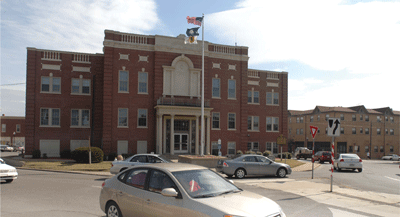
The H.B. Fife Courthouse is the heart of the public square downtown. Elizabethtown and county officials, along with the Chamber of Commerce, are looking at ways to bring businesses back to the downtown area. Motorists traveling through downtown must navigate around the courthouse as they travel on U.S. 31W.
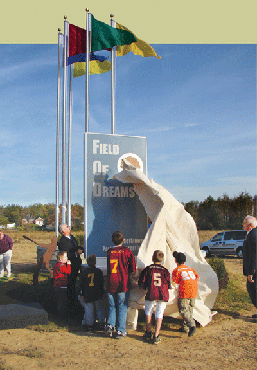
The 100-acre Field of Dreams isn’t much more than a sign at this point, but civic leaders hope that it will eventually draw football, soccer, baseball and softball teams from near and far. The city already has a substantial hospitality industry.
Through the fog of the current recession, Fort Knox looms golden to Elizabethtown, Ky.
The Army base, next to the U.S. bullion depository of the same name, came through the base realignment and closure exercise in 2005 with an enhanced mission. Over the next three years, it will bulk up into a bastion of 20,000 jobs, 5,500 of them new. The biggest share of the additions will come with the Army’s human resources command, to be consolidated at the fort from sites around the country. By one estimate, allowing for slots taken by current soldiers or Army employees, 1,500 to 1,800 of those new jobs will remain for civilians either in the Fort Knox area or recruited to it. These will be permanent jobs of the corporate-headquarters sort—managerial and technical included, all white-collar.
Although 15 miles outside of Elizabethtown and only partly in Hardin County, Fort Knox has long been the economic elephant in the area. More county residents—2,166 civilians, by the Army’s count—work at the post than for any other employer.
In addition, hundreds of local trades people have found temporary work on the fort’s many expansion-related construction projects, says B. Keith Johnson, president of Elizabethtown’s First Federal Savings Bank. Of these projects, the centerpiece is an office building of about 900,000 square feet—equal to the playing area of 15 football fields. In all, the Army’s investment in the base’s expansion is projected to approach $1 billion.
Larry Hayes, Kentucky’s acting economic development secretary, describes the base’s buildup as “one of the most significant economic development projects” in the state since the late 1980s, when Toyota opened its assembly plant in Georgetown, 85 miles from Elizabethtown.
Auto Plants Are Still Key
Toyota gave Elizabethtown its biggest shot of business adrenalin pre-Fort Knox. Over the following decade, parts makers Akebono Brake Corp. (auto brake systems), AGC Automotive Americas (automotive safety glass) and Dana Corp. (truck frames) built new plants in town. Tokyo-based Akebono took the extra step of moving its North American headquarters to Elizabethtown from Michigan in 2007.
Incentives helped attract the three plants. Elizabethtown Mayor David Willmoth says the city agreed to return to the plants, for five years, three-quarters of the 0.8 percent in taxes it collected on their employees’ earnings. In some cases, the city also issued industrial revenue bonds.
“We are always willing to work with clients to make their project work in our area,” especially in today’s slack economy, says Rick Games, president of the Elizabeth/Hardin County Industrial Foundation.
The foundation markets Elizabethtown as something of an incentive in itself, given its location, where two four-lane Kentucky parkways meet up with Interstate 65, which itself connects the Gulf Coast and suburban Chicago. From Elizabethtown, the new parts plants could easily supply Toyota and numerous new auto plants eventually built close to that interstate between Alabama and Indiana.
Akebono’s vice president and general manager, Carl Lay, says his company was won over by the city’s logistical pluses, which also included service by two rail lines and proximity to the Louisville airport, 40 miles and minutes north on Interstate 65. Akebono has since come to value “the progressiveness of the community,” exemplified, he says, in its openness to the Japanese managers who came with the plant.
Together over the years, Akebono and the other two parts plants created upward of 2,500 jobs, mostly nonunion, with good wages and benefits. Now, along with their automaker customers, all three have shifted into reverse. Akebono announced its first layoffs in January. Dana and AGC have been shedding jobs for several years and are down by half from their employment peaks, Games says.
Still, the three plants rank among the largest employers in the city, a roster topped by Hardin Memorial Hospital. For the past decade, the hospital has been adding services, facilities, medical specialties and jobs, extending its reach from Hardin into several surrounding counties and securing its standing as a regional medical center.
President David L. Gray says demand for the hospital’s services continues to grow, especially among people either uninsured or underinsured. The hospital’s bad debts ballooned 30 percent in the past year. Because the Army provides its people with excellent health benefits, he welcomes the new Fort Knox jobs, which will start arriving this summer.
Retailing Takes a Hit
For now, unemployment is ticking up. Mayor Willmoth sees the evidence in an expected $1 million shortfall in the $11.1 million in earnings taxes the city budgeted for this fiscal year. A downturn in retailing contributes to the gap, he says.
To the casual observer, the retailing sector looks healthy enough. On or near the four-lane Ring Road that draws a letter C just within the city limits, big-name stores like JCPenney, Lowe’s, Home Depot, Target, Best Buy, Kohl’s and Wal-Mart stand strong to all appearances, testifying to the regional shopping mecca Elizabethtown has become. A Sam’s Club opened in January. But a number of smaller stores—including Waldenbooks, KB Toys and the local outlets of two bankrupt regional clothing stores—have closed. Willmoth calculates that as many as 500 retailing jobs have been lost.
In housing, too, Elizabethtown has taken a blow from the brutal recession. Johnson of First Federal Savings says permits for new single-family homes fell 54 percent in the city and 51 percent in unincorporated Hardin County from 2006 to 2008. Willmoth mostly blames the slowdown in residential development for an overall drop in construction in the city—from $80 million worth of projects in 2007 to $59 million last year.
Included in that lower total, though, were two new hotels, which brought the city’s total to 21. Twelve of them cluster at the main Elizabethtown exit on Interstate 65, under a canopy of signs beckoning travelers in from the road.
Catering to Tourists
The hospitality industry serves the city well. Over the past 10 years, receipts from a longstanding 3-percent tax on hotel rooms—more than 1,500 of them now—have risen every year but one. Two years ago, the city added a 2-percent tax on restaurant meals. The take from the two taxes together this year is expected to add up to $2.7 million, earmarked for promoting tourism.
The city’s lead effort in that area is a planned 100-acre outdoor recreational complex. Its football, soccer, softball and baseball fields will be designed not just for local leagues but also for team competitions from beyond the immediate area. Sherry Murphy, executive director of the Elizabethtown Tourism & Convention Bureau, describes this venture in “sports tourism” as a potential economic-development tool.
Timothy Asher, president of the Elizabethtown-Hardin County Chamber of Commerce, praises the effort as an example of the community “trying new things” and not just relying on the “same old economic development efforts.” He also sees development potential for Elizabethtown in attracting retirees, especially military from Fort Knox, and in developing more homegrown entrepreneurs.
Both Asher and the foundation’s Games cited Michael and Dana Bowers as leading examples of entrepreneurs. The husband-wife duo combined two small enterprises into iPay Technologies. Their company provides software and customer service for online bill paying to community banks and credit unions. Since its founding in 2001, iPay has grown to 225 employees.
“Significant Skills Gap”
The community’s immediate and major focus is on Fort Knox, including the challenges of its explosive growth. To accommodate it, schools, roads and housing must be built. People must be hired, a task complicated by “a significant skills gap,” says Sherry Johnson, associate director of the eight-county Lincoln Trail Area Development District, headquartered in Elizabethtown. She says candidates for the new “knowledge-based” Fort Knox jobs, especially those in information technology, are in thin supply in the basically rural, blue-collar area. An effort is under way to recruit workers, including recent college graduates, from across northern Kentucky and southern Indiana.
“Smaller cities like Elizabethtown typically do not have the mix of amenities—air service, universities, restaurants, major sports, arts and cultural institutions—for luring high-paying office jobs of the kind Knox is providing,” says Paul A. Coomes, professor of economics at the University of Louisville and a specialist in regional economics. In the new Army jobs, he says, the area’s economy is “getting through the federal government what it would not likely get through the private sector.”
For the long haul, he sees the area as best suited for “attracting companies that have to make complicated, heavy, expensive things that have to be shipped to consumer markets throughout the United States.” Manufacturers, in other words.
Games is on the case. “There are a lot of manufacturing projects out there to be landed when this economy improves, especially those between five and 25 employees,” he says.
Even now, he says, he’s hearing from prospects whose interest has been piqued by all of the activity around Fort Knox.
Elizabethtown, Ky., by the numbers
| City Population |
23,777 (1)
|
| Hardin County Population |
97,949 (1)
|
| County Labor Force |
46,639 (2)
|
| County Unemployment Rate |
7.3 percent (2)
|
| County Per Capita Income |
$31,875 (3)
|
| (1) U.S. Bureau of the Census, estimate 2007 | |
| (2) Haver/Bureau of Labor Statistics, December 2008 | |
| (3) Bureau of Economic Analysis/Haver, 2006 | |
| Top Five Employers | |
| Hardin Memorial Hospital |
1,600 *
|
| Akebono Brake Systems |
825**
|
| Wal-Mart Stores Inc. |
600**
|
| Dana Corp. |
500**
|
| AGC Automotive Americas |
350**
|
| *Self-reported, February 2009 | |
| **SOURCE: Elizabethtown/Hardin County Industrial Foundation, February 2009 | |
Views expressed in Regional Economist are not necessarily those of the St. Louis Fed or Federal Reserve System.
For the latest insights from our economists and other St. Louis Fed experts, visit On the Economy and subscribe.
Email Us

